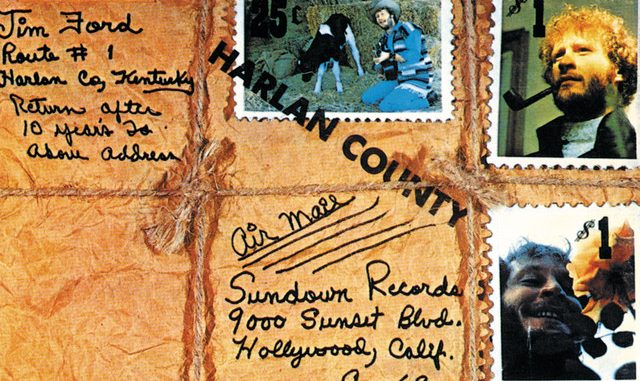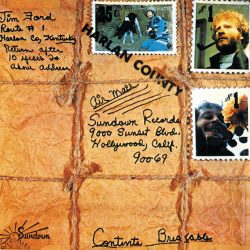
A template for americana from the musical earthquake year of 1969.
 Anyone who has any form of interest in americana will also be fully aware of the challenges of coming to a consensus on what constitutes americana. Jim Ford’s ‘Harlan County’ is not just an influential landmark album, it also beautifully encapsulates the nebulousness of what we now call americana as it is an expert mix of country rock, country soul, and funk. This eclecticism is also probably the reason the album isn’t as celebrated as other landmark 1969 albums such as The Band’s eponymous second album, the Stones’ ‘Let It Bleed’, Jefferson Airplane’s ‘Bless Its Pointed Little Head’ and ‘Volunteers’, Dylan’s ‘Nashville Skyline’, CSN’s ‘Crosby, Stills & Nash’, Beefheart’s ‘Trout Mask Replica’, the Beatles’ ‘Abbey Road’, Led Zepplin’s ‘I’ and ‘II’, and we haven’t even mentioned Creedence Clearwater Revival and Fairport Convention’s contributions.
Anyone who has any form of interest in americana will also be fully aware of the challenges of coming to a consensus on what constitutes americana. Jim Ford’s ‘Harlan County’ is not just an influential landmark album, it also beautifully encapsulates the nebulousness of what we now call americana as it is an expert mix of country rock, country soul, and funk. This eclecticism is also probably the reason the album isn’t as celebrated as other landmark 1969 albums such as The Band’s eponymous second album, the Stones’ ‘Let It Bleed’, Jefferson Airplane’s ‘Bless Its Pointed Little Head’ and ‘Volunteers’, Dylan’s ‘Nashville Skyline’, CSN’s ‘Crosby, Stills & Nash’, Beefheart’s ‘Trout Mask Replica’, the Beatles’ ‘Abbey Road’, Led Zepplin’s ‘I’ and ‘II’, and we haven’t even mentioned Creedence Clearwater Revival and Fairport Convention’s contributions.
Jim Ford was primarily a songwriter who wrote songs covered by Aretha Franklin, Bobbie Gentry, Bobby Womack, and The Temptations at the height of their popularity, among others. He was part of Sly Stone’s circle and Sly called him “The baddest white man on the planet”. He was a major influence on the British pub rock scene through his influence on Brinsley Schwarz, and Nick Lowe has cited him as his biggest influence. Jim Ford only released one official album, excluding subsequent demo and unreleased track compilations, and this may have had something to do with his habit of taking record company advances and then disappearing. Nick Lowe has said how impressed he was when he first met Jim Ford in his cowboy boots and jeans with a sharp crease and with, according to legend, a $1m stash of cocaine around his waist. Ford had come to England to record an abortive album with Brinsley Schwarz, but Lowe and The Brinsleys got access to some unreleased, at the time, songs including ‘Ju Ju Man’. While he continued to write for artists like Bobby Womack and The Temptations in the ‘70s and into the ‘80s and receive songwriting royalties, Jim Ford suffered from varying degrees of substance abuse and never managed to get his career back on track after the mid-’80s., dying in his trailer in Mendocino, California, in 2007 just before a charity gig for him was to take place in London.
Jim Ford was born in Johnson County, Kentucky, in 1941, and ended up in Los Angeles in 1966 after a stay in New Orleans, where his success as a songwriter was enough to derail his attempt to get to San Francisco’s Haight Ashbury. His success as an LA-based songwriter was sufficient for local label Sundown Records to give him a deal in 1969 that resulted in the self-produced ‘Harlan County’ whose ten songs included five covers and five Jim Ford songs. While Ford’s own exuberant but basic production and the use of A-list session musicians like James Burton, Jim Keltner and Dr John, and members of Redbone, make the record sound great, the real success of ‘Harlan Country’ is how the songs all hang together to paint a picture of the American South and the need to migrate to better yourself. The opening title track perfectly encapsulates the whole album as it tells Ford’s story of leaving poverty and Kentucky behind in search of a better life. Another standout track is ‘I’m Gonna Make Her Love Me’ which manages to mix all of Ford’s influences, including a good dollop of gospel, on a single track. His own track ‘Love On My Brain’ is a more tranquil examination of love without the male sexual bravado of the earlier track, which illustrates the complexity of Jim Ford as a performer and songwriter, a view confirmed by his take on Alex Harvey’s ‘To Make Me Beautiful’. The themes of travel and searching are explored on the covers of Delaney & Bonnie’s ‘Long Road Ahead’, and Willie Dixon’s blues classic, ‘Spoonful’. Ford’s co-write with Redbone’s Lolly Vegas, ‘Working My Way To LA’, combines these themes with his personal experiences.
You can imagine back in 1969 the record label wouldn’t have known how to market ‘Harlan Country’. The country parts were real country and bluegrass, the soul was real soul and the funk was real funk all on one record. Without an effective publicity campaign it is virtually impossible for a debut album to get any traction, no matter the quality of work. Nick Lowe is known for the subtlety and humour of his lyrics, and that same quality can be found in Jim Ford’s own songs. Also, while British white kids and American white students had to learn their root music from records, Jim Ford could claim that country, soul and funk were a natural part of his musical DNA. While it may have sunk without trace on its release, its influence on subsequent artists and the simple quality of the performances and cohesiveness of its themes and the near-perfect encapsulation of what eventually came to be called americana, means that it can stand shoulder to should with other leading albums of that musical golden year of 1969 whose influence can still be felt in today’s music.


